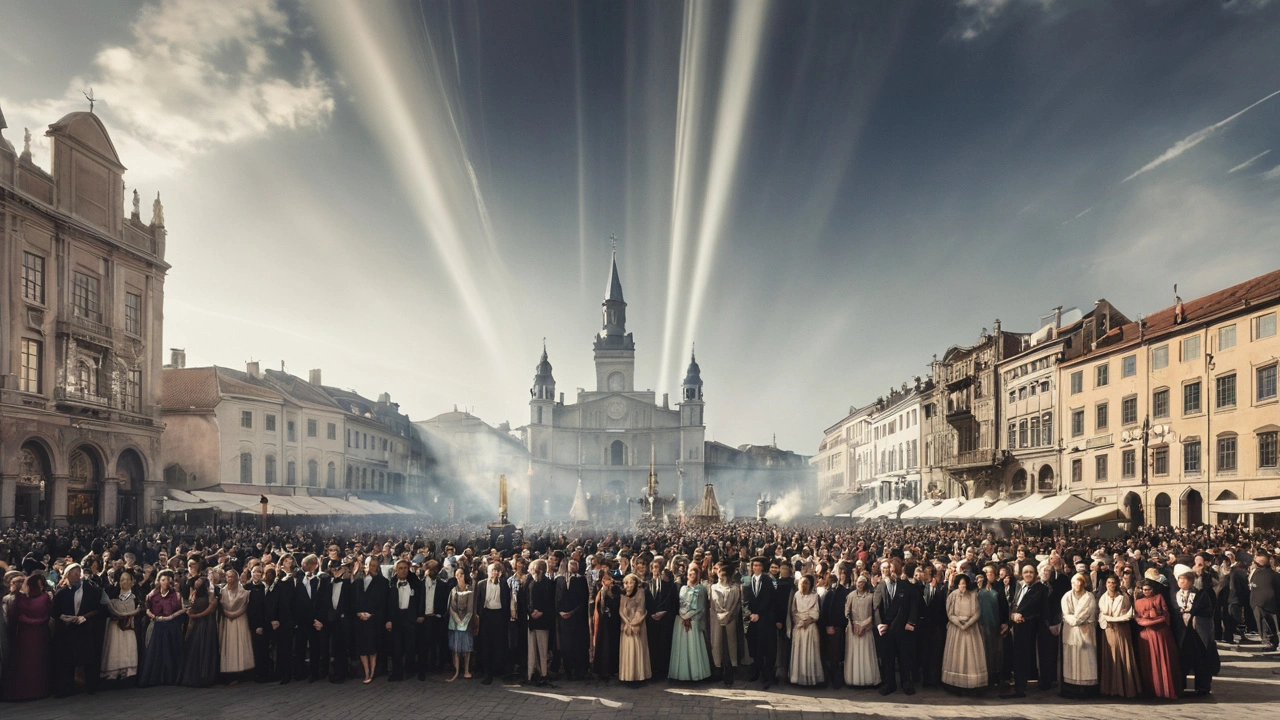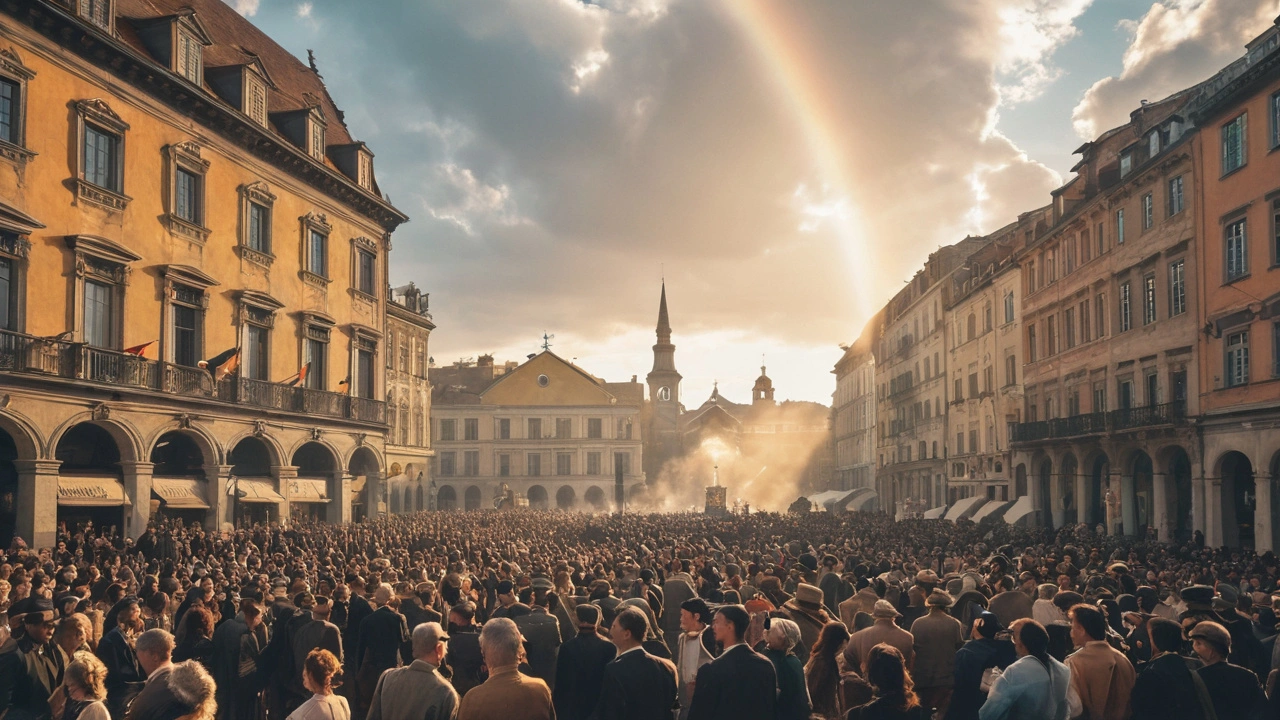Unleashing the Power and Potential of Revivalism for Cultural Growth
 Jul, 30 2024
Jul, 30 2024
Revivalism is more than just a term—it encapsulates movements that breathe new life into various spheres of society, from culture to religion and beyond. Often misunderstood or overlooked, the concept of revivalism holds tremendous potential to inspire change and reflection.
This article delves into the heart of revivalism, tracing its roots from historical examples to its influence on modern-day society. We’ll explore how these powerful movements have reawakened cultural identities, transformed societal norms, and ignited collective action. By understanding the core of revivalism, we uncover timeless principles that can be applied to initiate positive change and rejuvenate contemporary culture.
Join us on this enlightening journey and discover the power and potential lying dormant within revivalist ideas.
- Understanding Revivalism
- Historical Examples of Revivalism
- The Social and Cultural Impact
- Revivalism in Modern Times
- Tips for Embracing Revivalist Ideas
Understanding Revivalism
Revivalism is a concept deeply embedded in human history, describing movements that seek to rekindle passion, tradition, and values that might have faded over time. Essentially, a revival advocates for the reintroduction of something that once held significant cultural, social, or religious importance. It is not just a nostalgic look back but a dynamic process that aims to adapt and reintegrate essential elements from the past into the present.
Historically, one of the most notable examples of revivalism is the Great Awakening, a religious revival that swept through the American colonies in the 18th century. This period saw a surge in evangelical enthusiasm, transforming local communities and leaving an indelible mark on American culture. The Great Awakening emphasized personal faith and piety, leading to the establishment of new churches and a departure from established religious norms. The movement also had substantial political implications, promoting ideas of equality and democracy, which later influenced the American Revolution.
Revivalism isn't confined to religious movements. For instance, the Harlem Renaissance of the 1920s was a cultural revival that celebrated African American artistic expression. This movement empowered black artists, musicians, and writers, creating a new cultural identity and fostering a sense of unity and pride within the African American community. The Harlem Renaissance not only impacted African American culture but also played a crucial role in shaping modern American culture.
Moving beyond historical examples, the appeal of revivalism lies in its capacity to foster a sense of community and continuity. It serves as a bridge between past and present, creating a shared narrative that can unify diverse groups of people. Revivalism often emerges during times of crisis or significant societal change, as individuals seek comfort and meaning by reconnecting with their heritage. This makes revivalist movements particularly powerful in shaping social and cultural landscapes.
"Those who cannot remember the past are condemned to repeat it." — George Santayana
In contemporary times, the principles of revivalism are still very much alive, though often manifesting in different ways. From the resurgence of vinyl records and vintage fashion to the revival of traditional crafts and local food movements, the desire to preserve and reintegrate elements of the past continues to influence modern culture. These contemporary revivals help maintain cultural diversity and counterbalance the rapid pace of technological advancement and globalization.
Understanding revivalism allows for a deeper appreciation of its role in our societal evolution. Recognizing the underlying motivations behind these movements can help us harness their potential to inspire positive change. By examining the past through the lens of revivalism, we can identify timeless principles that can be adapted to address current challenges, fostering a more cohesive and resilient society.
Historical Examples of Revivalism
The annals of history are replete with powerful instances of revivalism that have reshaped societies and resurrected dormant cultures. One notable example is the Protestant Reformation in the 16th century. Instigated by Martin Luther's 95 Theses, this movement dramatically altered religious, cultural, and political landscapes across Europe. Luther's challenge to the Catholic Church’s practices not only initiated religious reforms but also empowered ordinary people to read and interpret scriptures for themselves, sowing seeds of intellectual awakening.
Another pivotal revivalist movement is the Great Awakening in the 18th century. Originating in the American colonies, this wave of religious enthusiasm brought about significant changes in religious practices and beliefs. The Great Awakening emphasized personal faith and emotional experiences over established traditions. Influential figures like Jonathan Edwards and George Whitefield traveled extensively, drawing massive crowds and inspiring a renewed sense of spirituality among the colonists. This movement also played a role in shaping the emerging American identity and democratic values.
The Great Awakening's impact is well recorded by historians. According to George M. Marsden, an American historian, "The Awakening was a major American moment in the development of individualistic religious expression and helped lead the colonies towards a shared identity."
In the realm of culture, the Harlem Renaissance of the 1920s stands as a stellar example of revivalism. This intellectual, social, and artistic explosion centered in Harlem, New York, saw African American culture celebrated and amplified like never before. Talented individuals such as Langston Hughes, Zora Neale Hurston, and Duke Ellington brought African American experiences to the forefront, challenging the prevailing racial stereotypes and inspiring a renewed sense of racial pride and cultural identity. The Harlem Renaissance also laid the groundwork for future civil rights movements by asserting the importance of African American voices.
Revivalism even found its place in the political sphere. Consider the Indian Independence movement led by Mahatma Gandhi. His adoption of nonviolent resistance and reviving ancient Indian practices like swadeshi, or self-reliance, ignited a national awakening. Gandhi’s strategies and revival of cultural symbols rallied millions in the struggle against British colonial rule, significantly contributing to India’s eventual independence. His methods have since inspired countless global movements advocating for civil rights and social justice.
These historical examples highlight the diverse contexts in which revivalism has thrived. From religious transformations and cultural renaissances to political upheavals, the power of revivalism lies in its ability to galvanize individuals and communities. By rekindling a sense of identity, purpose, and collective action, revivalist movements have consistently proven their potential to bring about profound change.

The Social and Cultural Impact
Revivalism has always played a pivotal role in shaping societies, often reflecting the collective aspirations and angst of the people involved. By rekindling interest in past traditions and beliefs, these movements not only revive cultural practices but also provide a platform for social change. For instance, the Great Awakenings in the United States were a series of religious revivals that had far-reaching effects on American society. They facilitated the growth of new denominations and inspired a wave of social reform, including the abolitionist and temperance movements.
These periods of revival brought ordinary people into active engagement with their communities, promoting a more inclusive and participatory social fabric. They fostered a sense of unity and shared purpose, often mobilizing communities to take collective action. This communal spirit was seen not just in religious circles but also in cultural revivals like the Harlem Renaissance, which celebrated African American culture and creativity during the 1920s. This period saw an explosion of artistic expression, which challenged prevailing racial stereotypes and inspired future generations to embrace their cultural heritage proudly.
“In every community, there is work to be done. In every nation, there are wounds to heal. In every heart, there is the power to do it.” — Marianne Williamson
The impact of revivalism extends beyond the arts and religion. It has the power to influence various societal norms, including fashion, language, and even lifestyles. The folk revival of the 1960s, often associated with artists like Bob Dylan and Joan Baez, brought traditional music back into popular culture while also serving as an anthem for social and political movements of the time. Through music, these artists raised awareness about civil rights, anti-war sentiments, and environmental issues, using their art as a tool for advocacy and change.
One can't overlook the role of revivalism in keeping languages and dialects alive. In places where dominant languages threaten to overshadow native tongues, revival movements help preserve linguistic diversity. Take the efforts to revive the Māori language in New Zealand, for example. Through educational programs, media broadcasts, and community initiatives, the language has seen a resurgence, ensuring that future generations can connect with their cultural roots.
Revivalism and Identity
The revitalization of cultural practices also provides individuals with a sense of identity and belonging. During periods of rapid modernization, people often feel disconnected from their heritage. Revivalist movements offer a means of reclaiming and celebrating that heritage, fostering a sense of pride and continuity. This reconnection can be particularly powerful in diasporic communities, where people seek to maintain their cultural identity while adapting to new environments. For instance, the Celtic Revival in the late 19th and early 20th centuries reinvigorated interest in Irish culture, literature, and art, playing a significant role in the country's quest for independence and national identity.Revivalism also encourages intergenerational dialogue, creating opportunities for older generations to pass down knowledge and traditions to the younger ones. This transmission of cultural wisdom not only preserves the past but also enriches the present, offering valuable lessons and insights that remain relevant. By bridging the gap between generations, revivalist movements help build stronger, more cohesive communities.
Revivalism in Modern Times
Revivalism, a phenomenon once closely associated with religious movements, has found new expressions in our contemporary world. It's amazing how this concept has evolved and adapted to the needs and nuances of modern society. Today, revivalism is not just about spirituality but encompasses various cultural, social, and even political domains.
One significant example of modern revivalism is seen in the resurgence of traditional crafts and arts. There's a growing movement to revive ancient techniques such as weaving, pottery, and blacksmithing. These crafts, which were once on the brink of extinction due to industrialization, are now being revitalized by artisans and enthusiasts. They believe these practices hold cultural significance and offer unique, sustainable alternatives to mass-produced goods. This trend is visible in the rise of craft fairs, workshops, and social media communities dedicated to preserving and promoting traditional skills.
Additionally, language revival efforts have gained momentum in recent years. Languages like Hebrew, which was nearly extinct, have been successfully revived and are now spoken fluently by millions in Israel. Similarly, there are movements to resurrect other endangered languages worldwide. For instance, the Maori language in New Zealand and the Hawaiian language in the United States have seen renewed interest and support. Schools, immersion programs, and digital platforms are playing a pivotal role in this linguistic revival, ensuring that these languages live on for future generations.
In the realm of music, revivalism has led to the resurgence of vinyl records. Despite the convenience of digital music, there's an increasing number of people who prefer listening to music on vinyl. This format provides a richer, more authentic sound experience that many argue digital files cannot replicate. Record stores, once thought to be relics of the past, are now thriving again, catering to both seasoned collectors and new enthusiasts discovering vinyl's charm.
Fashion is another area where revivalist trends are evident. Vintage clothing and retro styles have made a major comeback. People are increasingly seeking out timeless fashion pieces from past decades, driven by a desire for uniqueness and sustainability. Vintage shops are thriving, and designers often draw inspiration from past fashions, blending old and new to create modern yet nostalgic collections. This revival promotes a more sustainable approach to fashion, counteracting the fast fashion industry’s environmental impact.
Revivalism’s influence extends to the culinary world too. Traditional recipes and methods are being rediscovered and cherished. Farm-to-table dining has become more prevalent, emphasizing locally sourced, seasonal ingredients. Chefs are exploring and reviving ancient cooking techniques, from fermenting and pickling to open-fire cooking. This trend not only preserves culinary heritage but also promotes healthier and more sustainable eating habits.
One notable aspect of modern revivalism is its accessibility. Unlike in the past, social media and digital technology facilitate the sharing and spreading of revivalist ideas. Online communities and platforms allow enthusiasts from around the world to connect, share knowledge, and support each other’s efforts. Virtual workshops, tutorials, and forums make it easier than ever to learn and participate in revivalist movements, democratizing the process.
In the political sphere, revivalism can be seen in the form of movements advocating for the renewal of certain ideologies or policies. For example, the growing interest in environmental conservation and renewable energy can be viewed as a revival of early environmentalist principles from the 1970s. These movements emphasize sustainability, aiming to inspire a return to practices that respect and protect nature. Advocacy, education, and activism are key components driving political and social change in this regard.
Revivalism in modern times demonstrates that the desire to reconnect with the past and preserve valuable traditions is very much alive. Whether it’s through traditional crafts, language preservation, or culinary heritage, these movements foster a sense of identity and continuity. More importantly, they provide meaningful alternatives to mainstream practices, encouraging diversity, sustainability, and cultural richness.

Tips for Embracing Revivalist Ideas
Embracing revivalist ideas can be a journey of rediscovery and transformation. To do this effectively, it’s important to understand the principles that have driven successful revivalist movements in history. The first tip is to delve into the past and learn from it. Study historical movements that have rekindled cultural or religious enthusiasm and note the strategies and actions that made them successful. For example, the Great Awakening in 18th century America was marked by fervent preaching and a return to spiritual basics, which helped to galvanize a fragmented society.
Modern revivalism encourages communities to return to their roots while adapting to contemporary needs. A key aspect is tapping into local traditions and customs that have been forgotten or neglected. Community leaders can organize events that celebrate cultural heritage, such as traditional music festivals or food fairs. These gatherings can reignite a collective sense of identity and belonging, fostering unity and pride among participants. Reviving these customs not only preserves tradition but also strengthens community bonds.
Another important tip is to focus on inclusivity. Revivalist movements thrive on the participation of diverse groups within society. By ensuring that all community members have a voice and can contribute, revivalism can become a unifying force. This can be achieved through open forums, workshops, and collaborative projects that encourage people from different backgrounds to share their perspectives and ideas. When everyone feels that they are part of something larger, the movement gains momentum and breadth.
In the digital age, using technology to spread revivalist ideas is a smart move. Social media platforms, for instance, can be powerful tools for raising awareness, organizing events, and engaging with a wider audience. Creating captivating content such as videos, podcasts, and blog posts that highlight the goals and activities of the revivalist movement can draw in new supporters and maintain momentum. A well-maintained online presence ensures that the movement resonates with both local and global audiences.
“True revival lies between the extremes of wild emotionalism and dead orthodoxy. It is a newly awakened soul.” - Charles Grandison Finney
It's also crucial to maintain a sense of authenticity. Revivalist movements often falter when they lose touch with their core values or become overly commercialized. Staying true to the original spirit and purpose of the revival can help maintain its integrity and long-term sustainability. Leaders must stay grounded and continually reflect on the movement’s origins and objectives, ensuring that activities and messaging align with core principles.
Creating educational programs is another effective strategy. Educating the younger generation about the importance of heritage and culture can instill a sense of value and appreciation from an early age. Schools and community centers can offer workshops and courses that explore historical themes, cultural practices, and the significance of revivalism. This not only preserves knowledge but also empowers individuals to carry forward the legacy.
Lastly, collaboration with other like-minded groups can amplify efforts. By joining forces with organizations that share similar goals, revivalist movements can leverage additional resources, expertise, and networks. These partnerships can bring in fresh perspectives and ideas, helping to sustain the movement over the long term. Collaborative efforts also create a broader impact, reaching beyond the immediate community and inspiring wider societal change.
Embracing revivalist ideas requires a delicate balance of respecting historical roots while innovating for the future. By learning from the past, celebrating cultural identity, fostering inclusivity, leveraging technology, maintaining authenticity, educating the youth, and collaborating with allies, one can unlock the immense potential that revivalism holds for societal growth and transformation.